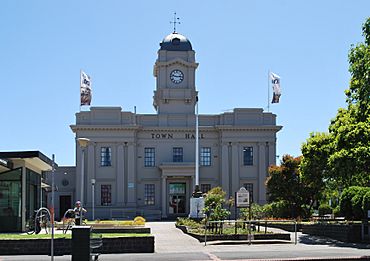Geelong West, Victoria facts for kids
Quick facts for kids Geelong WestGeelong, Victoria |
|||||||||||||||
|---|---|---|---|---|---|---|---|---|---|---|---|---|---|---|---|

The former City of Geelong West Town Hall
|
|||||||||||||||
| Population | 6,966 (2016 census) | ||||||||||||||
| Postcode(s) | 3218 | ||||||||||||||
| LGA(s) | City of Greater Geelong | ||||||||||||||
| State electorate(s) | Geelong | ||||||||||||||
| Federal Division(s) | Corio | ||||||||||||||
|
|||||||||||||||
Geelong West is a busy suburb in Geelong, Victoria, Australia. It has both shops and homes. When Geelong was first started, this area was called Kildare. But in 1875, its name changed to Geelong West. The main street here is Pakington Street. In 2016, about 6,966 people lived in Geelong West.
Contents
A Look Back: The History of Geelong West
From Kildare to Geelong West
Long ago, a part of what is now Geelong West was known as Ashby. This area was west of Latrobe Terrace, between Aberdeen Street and Church Street. By 1850, people also called it Little Scotland or Kildare. At that time, Ashby mostly referred to the area between Autumn Street and Waratah Street.
In 1875, the whole Ashby area officially became Geelong West. The Ashby state school, which had just opened that year, also changed its name to Geelong West. Later, in 1988, the school changed its name back to Ashby as part of Australia's 200th birthday celebrations.
Post Offices and Transport
A Post Office named Geelong West first opened on 1 July 1865. However, it was later replaced and renamed Geelong North Railway Station in 1886. On 1 April 1887, the Geelong West office reopened close to where it is today. In 1960, another Post Office called Shandeen opened near Aberdeen Road and Shannon Avenue.
From 1912 until 1956, electric trams ran through Pakington Street in Geelong West. These trams helped people get around. After 1956, buses took over the service.
Local Industries and Changes
There was once a large rope-making factory called M. Donaghy & Sons in Pakington Street. This factory made ropes for many uses. Today, that area has been redeveloped into a shopping centre. It now has a Woolworths supermarket and other shops.
Places of Historical Importance
Geelong West has several places that are important for their history. These are called heritage-listed sites. They include:
- 22 Pakington Street, known as the Harp Inn
- 95 Pakington Street, the site of Donaghy's Rope Walk
- 233 Pakington Street, the Reformed Church of Geelong
- 9 Gertrude Street, a historic Residence
- 202 Aberdeen Street, the Shearers Arms Hotel
- 127 Elizabeth Street, a building called St Elmo
How Geelong West Was Governed
Local Government Changes
In 1875, Geelong West became a local government area called the Geelong West Borough. A "borough" is like a small town or district with its own local council. In 1922, it was officially called a Town.
In 1926, the Geelong West Town expanded by taking in a part of Corio Shire called Moorpanyal riding. Then, in 1929, Geelong West was declared a City. This meant it had grown larger and more important.
Joining Greater Geelong City
In 1993, many local government areas in the region joined together to form one big council area. Geelong West City combined with parts of Bannockburn Shire, Barrabool Shire, Bellarine Rural City, Corio Shire, Geelong City, Newtown City, and South Barwon City. Together, they created the Greater Geelong City.
Famous People from Geelong West
J. F. Archibald, a well-known journalist and publisher, was born in Geelong West in 1856. He helped start a famous Australian magazine called The Bulletin. In 1956, a special statue of his head, called a bust, was put up at the corner of Weddell Road and Church Street to remember him.
Pako Festa: A Celebration of Cultures
The Pako Festa is a big yearly festival held in Pakington Street, Geelong West. It usually happens around late February. For example, in 2006, it was held on February 25. This festival celebrates cultural diversity and showcases the amazing artwork and fashion created by people in the Geelong area. It's a fun way to learn about different cultures!
Sports in Geelong West
Geelong West is home to several sports teams. There is an Australian rules football team that plays in the Geelong Football League. Another team from the suburb competes in the Geelong & District Football League. These teams give local players a chance to compete and represent their community.


